中职英语,基础模块1 Unit2 说课稿
中职英语基础模块第一册Unit2说课课件
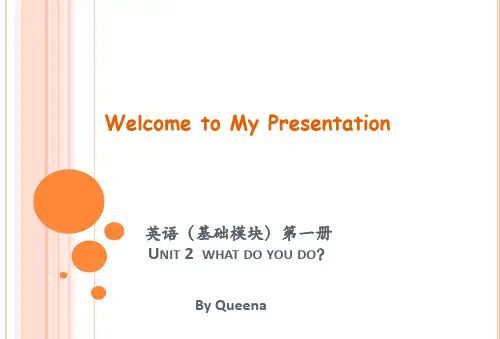
Teaching Methods
一、Analysis of Textbook
Different topics that close to students’ life
Various tasks and activities to enrich learning
Standard and practical language that helpful for students
My name is …
How old are you?
I’m …
What do you do?
I’m a …
★ Reading and Writing
Competition (Make sentences one by one)
eg: I want to go to Disneyland. We go shopping together. ……
Key Points
Difficult Points
Key Words.
(secretary, technician, shop assistant…)
Key sentences.
(what do you do? I work for … I love my job.)
Grammar.
1.Indenifite article. a nurse, an assistant
Affection aims
• Whether Ss develop the sense of cooperation
• Whether Ss have more confidence of learning English
放映结束 感谢各位批评指导!
谢 谢!
高教版中职英语基础模块-第1册unit-2《i-can-do-it》教案.doc
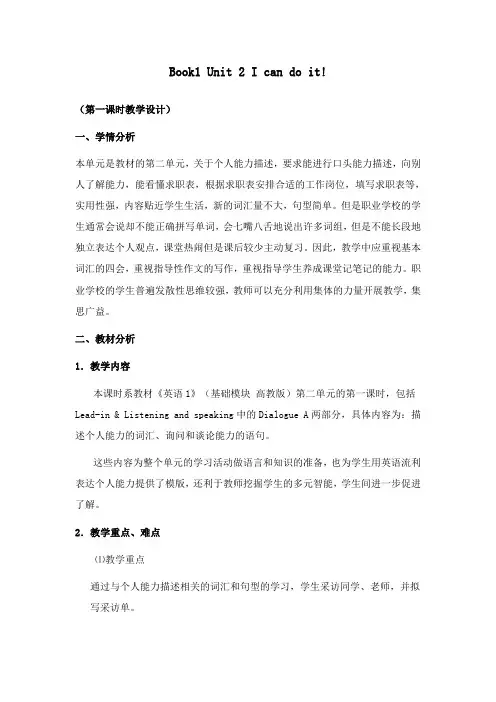
Book1 Unit 2 I can do it!(第一课时教学设计)一、学情分析本单元是教材的第二单元,关于个人能力描述,要求能进行口头能力描述,向别人了解能力,能看懂求职表,根据求职表安排合适的工作岗位,填写求职表等,实用性强,内容贴近学生生活,新的词汇量不大,句型简单。
但是职业学校的学生通常会说却不能正确拼写单词,会七嘴八舌地说出许多词组,但是不能长段地独立表达个人观点,课堂热闹但是课后较少主动复习。
因此,教学中应重视基本词汇的四会,重视指导性作文的写作,重视指导学生养成课堂记笔记的能力。
职业学校的学生普遍发散性思维较强,教师可以充分利用集体的力量开展教学,集思广益。
二、教材分析1.教学内容本课时系教材《英语1》(基础模块高教版)第二单元的第一课时,包括Lead-in & Listening and speaking中的Dialogue A两部分,具体内容为:描述个人能力的词汇、询问和谈论能力的语句。
这些内容为整个单元的学习活动做语言和知识的准备,也为学生用英语流利表达个人能力提供了模版,还利于教师挖掘学生的多元智能,学生间进一步促进了解。
2.教学重点、难点⑴教学重点通过与个人能力描述相关的词汇和句型的学习,学生采访同学、老师,并拟写采访单。
⑵教学难点学生了解词汇记忆的策略之一——分类记忆;学生区分出不同购物场所的特点;三、教学目标1.知识目标⑴学生能掌握描述个人能力的词汇,如speak Chinese, drive cars, repair puters, teach English, read in Chinese, serve customers。
⑵学生能掌握询问和描述个人能力时所使用的句型,如:Can you say something about yourselfCan you sing English songsWell, I can teach English and I can speak a little Chinese.2.能力目标⑴学生能听懂关于询问和描述个人能力的对话。
中职《英语基础教程》第一册Unit2-3
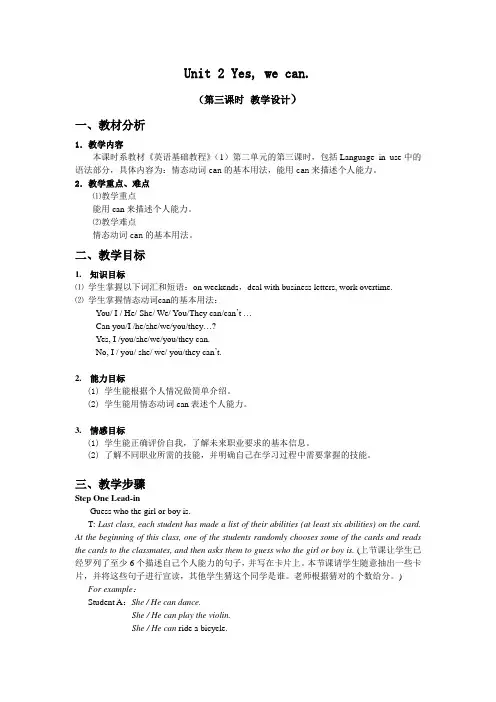
Unit 2 Yes, we can.(第三课时教学设计)一、教材分析1.教学内容本课时系教材《英语基础教程》(1)第二单元的第三课时,包括Language in use中的语法部分,具体内容为:情态动词can的基本用法,能用can来描述个人能力。
2.教学重点、难点⑴教学重点能用can来描述个人能力。
⑵教学难点情态动词can的基本用法。
二、教学目标1.知识目标⑴学生掌握以下词汇和短语:on weekends,deal with business letters, work overtime.⑵学生掌握情态动词can的基本用法:-You/ I / He/ She/ We/ You/They can/can’t …-Can you/I /he/she/we/you/they…?-Yes, I /you/she/we/you/they can.-No, I / you/ she/ we/ you/they can’t.2.能力目标(1) 学生能根据个人情况做简单介绍。
(2) 学生能用情态动词can表述个人能力。
3.情感目标(1) 学生能正确评价自我,了解未来职业要求的基本信息。
(2) 了解不同职业所需的技能,并明确自己在学习过程中需要掌握的技能。
三、教学步骤Step One Lead-inGuess who the girl or boy is.T: Last class, each student has made a list of their abilities (at least six abilities) on the card. At the beginning of this class, one of the students randomly chooses some of the cards and reads the cards to the classmates, and then asks them to guess who the girl or boy is. (上节课让学生已经罗列了至少6个描述自己个人能力的句子,并写在卡片上。
高教版中职英语基础模块一 Unit 2 Listening and Speaking精美课件
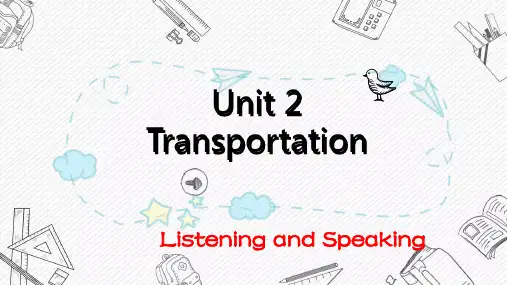
她向窗子的方向看了看,无奈什么也没有。
Language points analysis
Visitor: Oh! Maybe I should get off and take a taxi.
how long 多久 Eg: How long have you studied English?
你学英语多久了?
Language points analysis
Li Zixuan: Don’t worry about it. It’ll only take about half an hour. By the way, it’s much greener than taking a taxi.
Expressions
go straight go along
Expressions
Hale Waihona Puke turn leftturn right
Expressions
crossroads
turning
Think and act.
根据以下校园地图和提示信息,以校门为起点,进行问路与指路的简单对话。
Excuse me, could you tell me how to go to the …?
much 修饰比较级,much greener “环保得多”green 意为“环保得”
by the way 顺便一提
补充:
on the way home on the way to …
在回家的路上 在去…的路上
Eg:顺便一提,你的手机号码是多少?
中职英语说课稿5篇

中职英语说课稿中职英语说课稿5篇作为一名人民教师,时常需要用到说课稿,借助说课稿我们可以快速提升自己的教学能力。
说课稿要怎么写呢?以下是小编为大家收集的中职英语说课稿,希望能够帮助到大家。
中职英语说课稿1教学目标和要求本课是第2课时,教学目标主要是对课文中的对话进行阅读、巩固和拓展。
要求通过学习,学生能达到以下要求:1.知识目标能够牢固掌握好课文对话中的重点词汇词组;阅读对话并且根据提示完成对话,运用已经学会知识让学生分角色进行口语练习,特别要求记忆Sarah所说的话并能当堂表演对话。
能够拓展对话,根据图片内容创作一段对话。
2.能力目标能够独立阅读课文对话,能够正确理解课文对话并根据提示完成对话,能够用英语表达歉意和接受道歉并学会为工作中所犯的错误致歉。
能够拓展对话,完成看图说话并把每张图片的对话内容连在一起形成一段对话。
3.情感目标通过小组讨论,培养同学们的交际能力和团队合作精神;不同的教学目标和要求A.对于基础相对好的同学,能够阅读对话并且根据提示完成对话,运用已经学会知识让学生分角色进行口语练习,能当堂表演对话,能够拓展对话,根据图片内容创作一段对话。
B.对于基础中等的同学,能够完成课文对话,分角色进行口语练习,能当堂表演对话。
C.程度较弱的同学,要求能够熟练掌握课文中的生词和词组,能够正确完成课文对话。
教学重点英语道歉和接受道歉的词汇及表达;学习英语在工作中犯错误的表达;根据提示完成对话;表演对话;教学难点根据提示完成对话,表演对话,拓展对话,根据图片创作对话。
学情分析该班部分学生英语基础比较好,部分比较薄弱,学习的主动性参差不齐,性格普遍也比较内向。
教学指导思想鉴于以上情况,本人在教学活动中采用任务型教学,充分调动学生学习的主动性,积极性,自觉性,充分体现课堂上学生为主,教师为辅,师生互动的指导思想,让每一个学生都能"动"起来,不同层次的学生都能有一定的提高。
教学活动热身练习:整堂课的教学活动设计是由易到难的。
中职英语,基础模块1 Unit2 说课稿
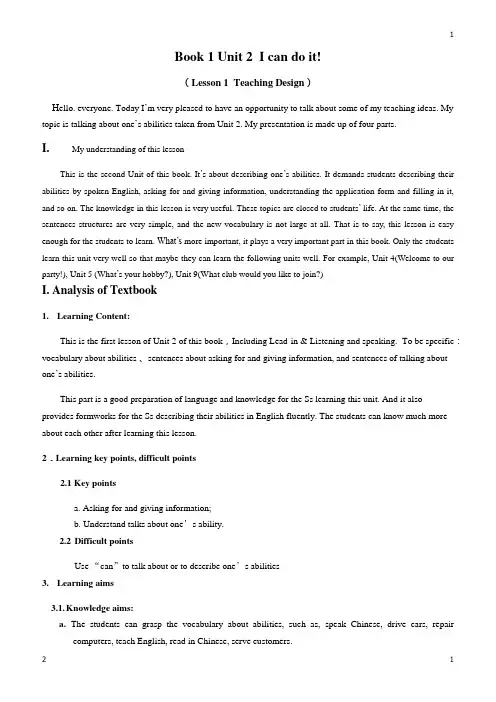
Book 1 Unit 2 I can do it!(Lesson 1 Teaching Design)H ello. everyone. Today I’m very pleased to have an opportunity to talk about some of my teaching ideas. My topic is talking about one’s abilities taken from Unit 2. My presentation is made up of four parts.I.My understanding of this lessonThis is the second Unit of this book. It’s about describing one’s abilities. It demands students describing their abilities by spoken English, asking for and giving information, understanding the application form and filling in it, and so on. The knowledge in this lesson is very useful. These topics are closed to students’ life. At the same time, the sentences structures are very simple, and the new vocabulary is not large at all. That is to say, this lesson is easy enough for the students to learn. What’s more important, it plays a very important part in this book. Only the students learn this unit very well so that maybe they can learn the following units well. For example, Unit 4(Welcome to our party!), Unit 5 (What’s your hobby?), Unit 9(What club would you like to join?)I. Analysis of Textbook1.Learning Content:This is the first lesson of Unit 2 of this book,Including Lead-in & Listening and speaking. To be specific:vocabulary about abilities 、sentences about asking for and giving information, and sentences of talking about one’s abilities.This part is a good preparation of language and knowledge for the Ss learning this unit. And it also provides formworks for the Ss describing their abilities in English fluently. The students can know much more about each other after learning this lesson.2.Learning key points, difficult points2.1 Key pointsa. Asking for and giving information;b. Understand talks about one’s ability.2.2Difficult pointsUse “can”to talk about or to describe one’s abilities3.Learning aims3.1.Knowledge aims:a. The students can grasp the vocabulary about abilities, such as, speak Chinese, drive cars, repaircomputers, teach English, read in Chinese, serve customers.b. The students can grasp these sentences for talking about abilities. For example,Can you say something about yourself?Can you sing English songs?Well, I can teach English and I can speak a little Chinese.3.2.Ability aimsa.The students can understand the dialogues about asking and describing abilities.b.The Ss can list one’s abilities, and can ask for and know abilities of their classmates.3.3.Emotional aims:To cultivate the students’ confidence, at the same time, they can appreciate each other.II.Analysis of studentsGenerally speaking, the students in vocational school often speak just English words, they can’t spell them rightly. They usually speak out many words but they can’t express their ideas with long sentences. They are not willing to review the lessons by themselves. Thus the application of the new vocabulary, the writing, and the notes the Ss taken should be taken seriously. On the other side, the Ss have strong divergent thinking ability so that the teacher can take most use of it and have a good atmosphere.III.Teaching MethodsGames and Competition, Situational teaching, Group work, Performance, Mission, Imatation.IV.Teaching ProcedureStep One Lead-in (8 min)1.Facts or lies: Start with a game. The teacher makes a list of his abilities, and two of them are lies. Askthe students to pick them out.Eg. I can read in English.I can sing many English songs….(Design intent: the teacher set examples with herself so that attracting Ss’ attention and shorten the communication distance between teacher and students. And these vocabularies can appear naturally. It also lays a solid foundation for their fluent oral English.)2.Guess Who I am: The teacher gives each student a card and ask each of them to make a list of theirabilities (at least five abilities) on the card. Two of the abilities should be lies. ..(Design intent: to make the Ss find their advantages, exercise their writing and spelling abilities. Ss reading in the front of the class are good to for them to cultivate confidence and bravery, but also their oral English. The teacher do this game can grasp students eyes tightly. What’s more, it’s also a presentation of their works.)3.Look and complete. (activity 1 on page16) Show the students a group of pictures. Then ask thestudents to describe each picture, using the sentence pattern “He/She/They can …” After that, theteacher may ask the students to listen to the tape and circle what Ben can do.(Design intent: the teacher can collect much more pictures to describe abilities. Through the presentation by PPT, the Ss can practice their observation ability, language expression ability, and fast reaction ability. )Step Two Vocabulary teaching (8 min)1.Group competition: What can we do? (1 min)The teacher divides the whole class into four groups and asks each group to write down what they can do on the blackboard in the given time. The group that offers the most phrases about abilities will be the winner.(Design intent: Group competition is good for the Ss cultivating their awareness of teamwork and fair. They practice their braveness and spelling ability when they writing on the blackboard. The four groups do it at the same time, so that the teacher can collect many vocabularies as soon as possible. And that is a good way for Ss to accumulating words. )2.The teacher types these abilities phrases on PPT (the teacher may ask a student to type these phrases if thereis a good typist in class).(Design intent: this is an important part for Ss to memorize words. Typing phrases on PPT arouse the enthusiasm of showing up. )Step Four Production (20m)1.Make a similar dialogue with your partner. Ask some group to act their dialogue.(Design intent: Imitating the dialogue is easy for Ss to do, and good for them to familiar the dialogue and grasp important words and sentences. )Step Three Listening ( Activity 4,5,6,7 ) (12 min)1.Activity 4. Read and tick. Are these abilities necessary for applying a job?2.Activity 5. Listen and circle. What abilities does Zhang Qing have?3.Activity 6.Read and underline. Read after the tape and underline the sentences about a4.Activity 7. Listen and repeat. And practice the dialogue with your partner.(Design intent: After the former part, it is easy for Ss to finish Activity 4-7. And it is mainly practice Ss’listening and pronunciation here. )Step Five Homework(1m)1.Recite the dialogue (activity6) and make a similar dialogue.2.Remember and copy the following sentences twice.1I can speak Chinese. I can drive cars. I can repair computers.…(Design intent: to strengthen all the knowledge of this lesson. )。
中职高教版英语1基础模块(1--4单元教案)
课程名称
英语
授课时数
1-2
周 次
第2周
教学内容
Unit 1 Nice to meet you!
Lead-in, Listening andSpeaking,Readingand Writing
教学方式
Theory
Practicing
【主要教学内容】
Content:
1.Master the greetingstatements.
2.Understand the words and sentence patternsabout ask and offer personal information.
1)Words and expressions:name, first name; last name; name card; telephone number; age; address; e-mail address; job (engineer; manager; secretary; teacher; student; doctor; nurse; singer; fans); position(boss);name card andvocation.
【教学过程组织】Teachingprocess
Step One :Lead-in
1.The teacher greets each student: Good morning.Nice to meet you.MayIhave your name, please? Which school are you from? What do your parents do?
3.Let’s make it a rule: Let’s greet each other atthebeginning of each English lesson, using the following patterns.Teacher:Class begins.The monitor:Stand up.Teacher:Good morning/afternoon, boys and girls.Students:Good morning/afternoon, teacher.Teacher:How are you today?Students:We are fine. And you?
外研社中职英语基础模块第一册unit2教案
外研社中职英语基础模块第一册unit2教案XXXTopic: What Do You Do?XXX: 4Textbook: English (Basic Module) Book 1.published by Foreign Language Teaching and Research PressXXX:1.Review the usage of simple present tense and XXX.2.XXX.3.Master five nal vocabulary words.XXX:1.XXX future jobs.2.Be able to fill in simple forms.3.Be able to describe jobs using simple present tense.4.Be able to make simple ns.XXX:1.Through learning this unit。
understand the characteristics of nal school life and help students have confidence in their future careers.2.XXX.XXX:Master XXX.Be able to describe jobs using simple present tense and make simple ns.XXX:Mastering XXX.Using simple present tense to describe jobs and making simple ns.XXX:Projector。
PPT courseware.XXX:Lecture Method: Help students XXX.n Method: Use PPT courseware to XXX' interest in learning.This unit is based on the theme of introducing ns。
外研版中职英语基础模块第1册unit2 we are friends 说课
外研版中职英语基础模块第1册unit2 weare friends 说课《外研版中职英语基础模块第1册unit2 we are friends》是一本针对中职学生学习英语的教材,旨在通过具体的生活场景和情境来帮助学生掌握基础的英语语言能力。
本单元主要介绍了如何表达交友、介绍自己以及描述他人的能力。
本节课将介绍该单元中的3个话题,包括Greetings,Introducing oneself 和Describing others,重点在于如何激发学生的英语兴趣,帮助他们尝试在英语中表达自己的想法和意愿。
一、分析本单元本单元针对中职生的英语学习兴趣与实际情况,以日常生活中的实际交际场景为背景,通过短文、图片、语音等多种形式来使学生掌握基础的英语语言技能,学习如何表达交友、介绍自己以及描述他人的能力。
本单元包括三个主题:Greetings,Introducing oneself和Describing others。
本单元内容新颖,贴近生活,能让学生对英语产生浓厚兴趣,适合用于初次听英语或者英语基础较弱的中职学生学习。
二、教学目标1. 能正确使用着重语调、表情和手势问候他人;2. 能使用简单的句子介绍自己和他人;3. 能够使用形容词和动词描写他人的外貌、性格和爱好;4. 能够说出自己的兴趣爱好,以便能更好地与他人交流和建立友谊关系。
三、教学准备教师:教材、课件、黑板、笔、图片。
学生:相应的教材和笔。
四、教学过程1. 导入学习根据学生学习情况,教师可以引导学生在黑板上列出英文问候语,熟练掌握简单句型并基于简单的词汇来介绍自己。
同时,教师可以根据学生的实际情况,引导他们进行简单的自我介绍,让学生自由发挥,并鼓励他们提出问题。
2. 学习单词和短语通过课件和图片的形式,教授本单元学习的单词和短语,让学生能够准确理解和记忆。
这里,教师应该注重学习单词和短语的应用情境,让学生明白单词和短语在实际情景中如何使用。
3. 分组演示可以根据学生的实际情况,分组让学生演示一个简单的情景——如何介绍自己,受到节目的互动交流。
高教版中职英语基础模块1全套教案
高教版中职英语基础模块1全套教案教案一:Unit 1 Introduction to English教学目标:1. 了解英语的起源和发展历程。
2. 学习英语的基本发音规则和语音特点。
3. 掌握英语的基本问候语和自我介绍的表达方式。
教学重点:1. 英语的起源和发展历程。
2. 英语的基本发音规则和语音特点。
3. 英语的基本问候语和自我介绍的表达方式。
教学难点:1. 英语的发音规则和语音特点的掌握。
2. 自然流利地运用英语的问候语和自我介绍。
教学准备:1. 多媒体设备。
2. 讲义和练习题。
教学过程:Step 1: Lead-in1. Greet the students and introduce the topic of the lesson.2. Show pictures of different countries and ask students if they know any English-speaking countries.3. Ask students why they think English is important.Step 2: Presentation1. Introduce the origin and development of English.2. Show a timeline of the major events in English history.3. Explain the basic pronunciation rules and phoneticfeatures of English.4. Use audio or video materials to demonstrate the correct pronunciation.Step 3: Practice1. Divide the class into pairs or small groups.2. Give students a list of common greetings and ask them to practice using them in different situations.3. Have students practice introducing themselves to each other using the phrases and sentences learned.Step 4: Consolidation1. Review the key points of the lesson, including theorigin and development of English, pronunciation rules, and greetings.2. Ask students to summarize what they have learned intheir own words.Step 5: Assessment1. Give students a short quiz to test their understanding of the lesson.2. Assign homework, such as writing a short paragraph about the importance of English or practicing greetings and self-introductions.教案二:Unit 2 Numbers and Time教学目标:1. 学习基本的数字和时间表达方式。
- 1、下载文档前请自行甄别文档内容的完整性,平台不提供额外的编辑、内容补充、找答案等附加服务。
- 2、"仅部分预览"的文档,不可在线预览部分如存在完整性等问题,可反馈申请退款(可完整预览的文档不适用该条件!)。
- 3、如文档侵犯您的权益,请联系客服反馈,我们会尽快为您处理(人工客服工作时间:9:00-18:30)。
Book 1 Unit 2 I can do it!(Lesson 1 Teaching Design)H ello. everyone. Today I’m very pleased to have an opportunity to talk about some of my teaching ideas. My topic is talking about one’s abilities taken from Unit 2. My presentation is made up of four parts.I.My understanding of this lessonThis is the second Unit of this book. It’s about describing one’s abilities. It demands students describing their abilities by spoken English, asking for and giving information, understanding the application form and filling in it, and so on. The knowledge in this lesson is very useful. These topics are closed to students’ life. At the same time, the sentences structures are very simple, and the new vocabulary is not large at all. That is to say, this lesson is easy enough for the students to learn. What’s more important, it plays a very important part in this book. Only the students learn this unit very well so that maybe they can learn the following units well. For example, Unit 4(Welcome to our party!), Unit 5 (What’s your hobby?), Unit 9(What club would you like to join?)I. Analysis of Textbook1.Learning Content:This is the first lesson of Unit 2 of this book,Including Lead-in & Listening and speaking. To be specific:vocabulary about abilities 、sentences about asking for and giving information, and sentences of talking about one’s abilities.This part is a good preparation of language and knowledge for the Ss learning this unit. And it also provides formworks for the Ss describing their abilities in English fluently. The students can know much more about each other after learning this lesson.2.Learning key points, difficult points2.1 Key pointsa. Asking for and giving information;b. Understand talks about one’s ability.2.2Difficult pointsUse “can”to talk about or to describe one’s abilities3.Learning aims3.1.Knowledge aims:a. The students can grasp the vocabulary about abilities, such as, speak Chinese, drive cars, repaircomputers, teach English, read in Chinese, serve customers.b. The students can grasp these sentences for talking about abilities. For example,Can you say something about yourself?Can you sing English songs?Well, I can teach English and I can speak a little Chinese.3.2.Ability aimsa.The students can understand the dialogues about asking and describing abilities.b.The Ss can list one’s abilities, and can ask for and know abilities of their classmates.3.3.Emotional aims:To cultivate the students’ confidence, at the same time, they can appreciate each other.II.Analysis of studentsGenerally speaking, the students in vocational school often speak just English words, they can’t spell them rightly. They usually speak out many words but they can’t express their ideas with long sentences. They are not willing to review the lessons by themselves. Thus the application of the new vocabulary, the writing, and the notes the Ss taken should be taken seriously. On the other side, the Ss have strong divergent thinking ability so that the teacher can take most use of it and have a good atmosphere.III.Teaching MethodsGames and Competition, Situational teaching, Group work, Performance, Mission, Imatation.IV.Teaching ProcedureStep One Lead-in (8 min)1.Facts or lies: Start with a game. The teacher makes a list of his abilities, and two of them are lies. Askthe students to pick them out.Eg. I can read in English.I can sing many English songs….(Design intent: the teacher set examples with herself so that attracting Ss’ attention and shorten the communication distance between teacher and students. And these vocabularies can appear naturally. It also lays a solid foundation for their fluent oral English.)2.Guess Who I am: The teacher gives each student a card and ask each of them to make a list of theirabilities (at least five abilities) on the card. Two of the abilities should be lies. ..(Design intent: to make the Ss find their advantages, exercise their writing and spelling abilities. Ss reading in the front of the class are good to for them to cultivate confidence and bravery, but also their oral English. The teacher do this game can grasp students eyes tightly. What’s more, it’s also a presentation of their works.)3.Look and complete. (activity 1 on page16) Show the students a group of pictures. Then ask thestudents to describe each picture, using the sentence pattern “He/She/They can …” After that, theteacher may ask the students to listen to the tape and circle what Ben can do.(Design intent: the teacher can collect much more pictures to describe abilities. Through the presentation by PPT, the Ss can practice their observation ability, language expression ability, and fast reaction ability. )Step Two Vocabulary teaching (8 min)1.Group competition: What can we do? (1 min)The teacher divides the whole class into four groups and asks each group to write down what they can do on the blackboard in the given time. The group that offers the most phrases about abilities will be the winner.(Design intent: Group competition is good for the Ss cultivating their awareness of teamwork and fair. They practice their braveness and spelling ability when they writing on the blackboard. The four groups do it at the same time, so that the teacher can collect many vocabularies as soon as possible. And that is a good way for Ss to accumulating words. )2.The teacher types these abilities phrases on PPT (the teacher may ask a student to type these phrases if thereis a good typist in class).(Design intent: this is an important part for Ss to memorize words. Typing phrases on PPT arouse the enthusiasm of showing up. )Step Four Production (20m)1.Make a similar dialogue with your partner. Ask some group to act their dialogue.(Design intent: Imitating the dialogue is easy for Ss to do, and good for them to familiar the dialogue and grasp important words and sentences. )Step Three Listening ( Activity 4,5,6,7 ) (12 min)1.Activity 4. Read and tick. Are these abilities necessary for applying a job?2.Activity 5. Listen and circle. What abilities does Zhang Qing have?3.Activity 6.Read and underline. Read after the tape and underline the sentences about a4.Activity 7. Listen and repeat. And practice the dialogue with your partner.(Design intent: After the former part, it is easy for Ss to finish Activity 4-7. And it is mainly practice Ss’listening and pronunciation here. )Step Five Homework(1m)1.Recite the dialogue (activity6) and make a similar dialogue.2.Remember and copy the following sentences twice.I can speak Chinese. I can drive cars. I can repair computers.…(Design intent: to strengthen all the knowledge of this lesson. )。
